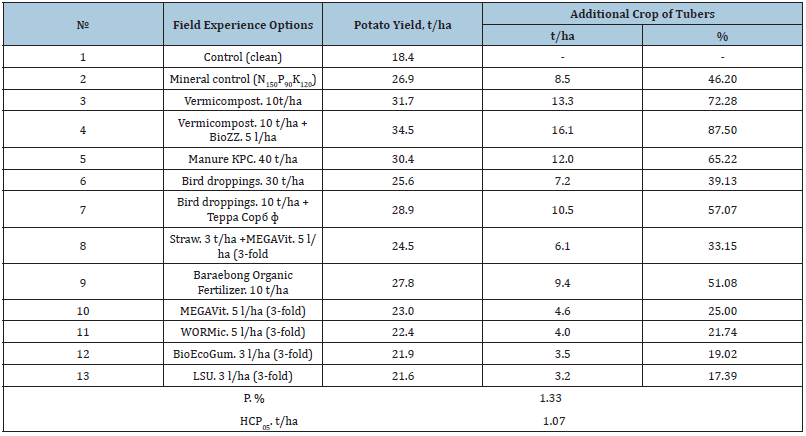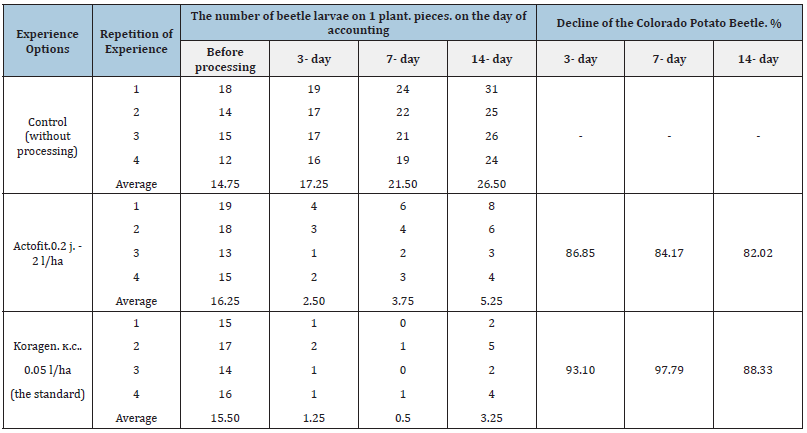- Submissions

Full Text
Annals of Chemical Science Research
The Effectiveness of Bio-Organic Fertilizers and Bioinsecticides on Potatoes in the Conditions of South-East Kazakhstan
Аitbaev ТЕ1*, Budanov NW2 and Kairekenova BS1
1LLP “Kazakh Research Institute of Fruit and Vegetable Growing”, Republic of Kazakhstan
2Kazakh National Agrarian Research University, Republic of Kazakhstan
*Corresponding author:Аitbaev ТЕ, LLP “Kazakh Research Institute of Fruit and Vegetable Growing”, Gagarin Avenue, 238/5, Almaty City , Republic of Kazakhstan
Submission: February 10, 2023;Published: February 17, 2023

Volume3 Issue4February , 2023
Abstract
Potatoes in Kazakhstan belong to a number of priority crops. Potato area - 195 thousand hectares, gross harvest-4 million tons. The country’s demand for potatoes is 2.7 million tons, security ~150%. Kazakhstan can become a producer and supplier of organic potatoes to the world market. It is also important to provide the local population with environmentally friendly, natural potatoes. To do this, it is necessary to develop technology for the production of organic potatoes. The article presents the results of research to assess the effectiveness of various types of bioorganic fertilizers and bioinsecticides on potatoes in the conditions of south-east Kazakhstan.
Keywords: Potatoes; Variety; Bio-organic fertilizers; Productivity; Yield; Quality; Organic products; Efficiency
Introduction
Potatoes are one of the main food products on a global scale, it ranks 4th in terms of production and consumption after wheat, rice and corn. In 2021, the sown areas of potatoes in all countries of the world amounted to 18 million hectares, the gross yield of products -376.1 million tons, the average yield of tubers -20.9 t/ha [1]. Potatoes in the Republic of Kazakhstan belong to a number of priority crops. Potato areas have increased markedly in recent years. In 2021, potatoes in the whole country were cultivated on an area of 195.2 thousand hectares, gross tuber harvests amounted to 4 million tons, the average crop yield was 20.5tons/ha. According to the physiological norm of nutrition, each resident should have 100kg of potatoes. With this in mind, the country’s demand is about 1.97 million tons (food potatoes). In addition, for seed purposes for planting about 200 thousand hectares (in 2022 potato areas amounted to 198.9 thousand hectares) about 0.7 million tons of potatoes are required annually.
In total, Kazakhstan needs 2.7 million tons of potatoes. If we analyze gross production (4 million tons) and demand (2.7 million tons), it can be seen that the supply of potatoes is 148% [2]. At the same time, Kazakhstan does not produce organic potatoes. Eco-friendly, natural potatoes can become a brand of our state. Kazakhstan can become a producer and supplier of organic potatoes to the world market. This is important and necessary for the domestic market, since providing the local population with environmentally friendly, highquality potatoes at an affordable price on a stable basis is an urgent task of the potato growing industry of the republic. In Kazakhstan, the production of organic products is just beginning. At the same time, this direction concerns limited types of crops [3]. Meanwhile, organic agriculture, including potato and vegetable growing, is intensively developing in many leading countries of the world. Every year more and more attention is paid to the development of organic production in the world; huge financial resources are allocated. Obviously, organic agriculture has a priority and a great future, since it is designed to produce natural, environmentally friendly products for humanity [4-12]. Our research on organic agrotechnology will have a positive impact on the formation and development of organic potato growing in Kazakhstan.
Materials and Methods
The research was carried out at the hospital of Kazakh Research Institute of Fruit and Vegetable Growing LLP, located in the foothill zone of south-east Kazakhstan (1050-1100m above sea level). The climate of the region is sharply continental. The duration of the warm period is 240-275 days. The sum of positive temperatures is 3450-3750 ˚C. The frost-free period is 140-170 days. The amount of precipitation is 350-600mm . The soils are dark chestnut, the granulometric composition is medium loamy, humus is 2.7-3.0%. The volume mass of the soil is 1.1-1.2g/cm3. The capacity of cation exchange is 20-21mg-eq. per 100g of soil. The reaction of the soil solution is slightly alkaline, pH 7.3-7.4.
The research was carried out within the framework of the project “Organic production of potatoes and table root crops (carrots, beets) based on the use of adaptive eco-friendly varieties and biologization of agricultural technology of crops in the conditions of the south-east of Kazakhstan” (2021-2023). The goal is to ensure the organic production of tubers and root crops based on the use of adaptive ecological varieties (hybrids) of domestic and foreign breeding and biologization of the main elements of agricultural technologies of potatoes and vegetable root crops for the conditions of the south-east of Kazakhstan. Methods of agrochemical research (Yudin F.A., 1980), methods of field experience (Dospekhov B.A., 1985), methods of field experience in vegetable growing (Litvinov S.S., 2011), methodological recommendations “Transition from traditional to bioorganic agriculture in the Republic of Belarus” (under the general editorship of KI Dovban, 2015) were used.
Results and Discussion
Bio-organic fertilizers had a positive effect on potato productivity. On the non-maneuverable control, the yield of tubers was the lowest and amounted to 18.4 t/ha. At the fertilized control, where mineral fertilizers were introduced into the soil under potatoes in the norms N150P90K120 for comparison with the studied biofertilizers, the yield of tubers increased sharply and reached 26.9t/ha, the value of the additional yield was 8.5t/ha or 46.20%. In the variant with Vermicompost at a rate of 10t/ha, the potato yield was 31.7t/ha, which is more than the control by 13.3t/ha or 72.28%. When combining Vermicompost (10t/ha) with BioZZ biofertilizer, the norm was 5l/ha (3-fold spraying of plants, only 15l), the potato yield in the experiment was the maximum - 34.5t/ha, the excess of the control was 87.50%. A fairly high yield of tubers (30.4t/ha) was also formed on the variant of the experiment, where manure was used as an organic fertilizer at a rate of 40t/ha, 65.22% of the production was additionally obtained here. It should be noted the high efficiency of bird droppings, which normally 30t/ ha, provided 25.6t/ha of potato harvest, this is higher than the control by 39.13%. The advantages of manure and bird droppings are that in the next 2-3 years their effectiveness manifests itself in the form of an aftereffect. Animal husbandry and poultry farming have been intensively developing in our country in recent years, so the volumes of these types of organic fertilizers will increase. A relatively high yield of tubers was obtained with the combined use of bird droppings (introduction into the soil at a rate of 10t/ha) and organic preparation (100%) Terra Sorb foliar (3-fold spraying at a rate of 3l/ha) -28.9t/ha, here the additional yield was equal to 10.5t/ha or 57.07%. The combined use of straw in crushed form at a rate of 3t/ha and the new MEGA Vit biofertilizer at a rate of 5l/ ha (3-fold use) also showed a high effect, providing an increase in potato productivity by 33.15%.
A significant increase in potato yield was provided with the use of a new organic fertilizer from South Korea-Baraebong Organic Fertilizer at a rate of 10t/ha -51.08%. MEGA Vit biofertilizer at a rate of 5l/ha (3 times) showed high efficiency, providing an additional 4.6t/ha (25.00%) yield. Liquid humic fertilizer from the Republic of Belarus should also be singled out, which contributed to an increase in the yield of tubers by 17.39%. In general, in 2022, all bio-organic fertilizers on potatoes were highly effective (Table 1).
Table 1:Effect of bio-organic fertilizers on potato yield (2022).

The analysis of potato productivity according to the variants of the experiment showed that about half of the studied bio-organic fertilizers are inferior to mineral fertilizers. So, if when applying a full mineral fertilizer to potatoes in the norm N150P90K120, the yield of potatoes in relation to pure control (without fertilizers) increased by 46.20%, then when using 6 types of organic fertilizers and biological products, the additional yield of tubers amounted to 17.39-39.13%. The studied types of fertilizers contain different amounts of macro- and microelements for plant nutrition, which explains the differences in potato yield according to the variants of the experiment.
The Colorado potato beetle (Leptinotarsa decemlineata) is a dangerous potato pest that can destroy crops by 50% or more. Therefore, the mandatory use of plant protection products is required. Potato growers in Kazakhstan use chemicals almost 100%. In organic production, the use of all types of pesticides is prohibited. Therefore, we have studied biological means of protecting potatoes. A new biological preparation Actofit (2 l/ha) was tested on potato plantings against imago and larvae of the Colorado potato beetle, which showed high biological efficiency (Table 2). The death rate of the Colorado potato beetle larvae reached 86.85%. The reference insecticide Koragen, K.S. (0.05l/ha) showed very high biological efficiency - up to 97.79%. The effect of the insecticide Koragen on the pest is higher, however, it is a chemical, environmental aspects are very important here.
Table 2:Biological efficacy of the biological preparation Aktarofit against the Colorado potato beetle (educational and experimental farm of NAO “KazNAIU”. 2022).

Conclusion
In the conditions of the foothill zone of the south-east of Kazakhstan, the use of bio-organic fertilizers and biostimulators of plant growth on potato plantings increased the yield of tubers by 12.50-88.09%. To combat the Colorado potato beetle, high efficiency (86.5%) is provided by the biological preparation Actofit, 0.2 w. (2.0 l / ha).
<Conclusion
Paper colorimetric detectors can be used for testing different PDMS membranes to select the best one for the IMS instrument. We want to select a thin membrane, relatively strong due to the presence of mechanical support and modified with PEO or PPO derivatives rapidly reacting to the CWA simulants action in the gas phase.
References
- World Potato Production (2023) (FAO)/Agribusiness magazine. Krasnodar, Russia, Volume 1.
- Official statistical data from the Committee on Statistics of the Ministry of National Economy of the Republic of Kazakhstan (05.01.2023).
- Grigoruk VV, Klimov EV (2016) Development of organic agriculture in the world and Kazakhstan/under the general editorship of H Mumindzhanov. Ankara, p.152.
- Khodakovskaya OV (2011) Global trends in the development of organic production. Economics, labor, management in agriculture 4: 70-73.
- Organic Farming in Germany (2013): www.bmelv.de/Shared Docs/Standardartikel/EN/Agriculture/Organic Farming /Organiс Farming in Germany.
- Willer H, Lernoud J (2016) The world of organic agriculture statistics and emerging trends 2016. FiBL-IFOAM Report, Frickand Bonn, PP. 34-114.
- Matthew Holmes, Anne Macey (2012) The World of Organic Agriculture, Canada. In: Willer Helga, Kilcher Lukas (Eds.), Statistics and Emerging Trends. FiBL-IFOAM Report. IFOAM, Bonn and FiBL, Frick, pp. 277-282.
- Ferreira VB, Costa Da Silva TT (2015) SRM and Srur, A.U.O.S. Food and Nutrition Sciences. Total Phenolic Compounds and Antioxidant Activity of Organic Vegetables Consumed in Brazil 6: 798-804.
- Kaminska A (2020) World experience of development of organic production. Agrosvet 17: 18-25.
- Organic World (2020) The World of Organic Agriculture.
- Organic Farming in Germany (2021) Federal Ministry of Food and Agriculture (BMEL), p. 14-15.
- Aitbayeva А, Zorzhanov B, Mamyrbekov Zh, Absatarova D, Rakhymzhanov B, et al. (2021) Comparison of different types of fertilizers on growth, yield and quality properties of watermelon (Citrullus lanatus) in the Southeast of Kazakhstan. Eurasian Journal of Soil Science 10(4): 302-307.
© 2023 Аitbaev ТЕ. This is an open access article distributed under the terms of the Creative Commons Attribution License , which permits unrestricted use, distribution, and build upon your work non-commercially.
 a Creative Commons Attribution 4.0 International License. Based on a work at www.crimsonpublishers.com.
Best viewed in
a Creative Commons Attribution 4.0 International License. Based on a work at www.crimsonpublishers.com.
Best viewed in 







.jpg)






























 Editorial Board Registrations
Editorial Board Registrations Submit your Article
Submit your Article Refer a Friend
Refer a Friend Advertise With Us
Advertise With Us
.jpg)






.jpg)














.bmp)
.jpg)
.png)
.jpg)










.jpg)






.png)

.png)



.png)






